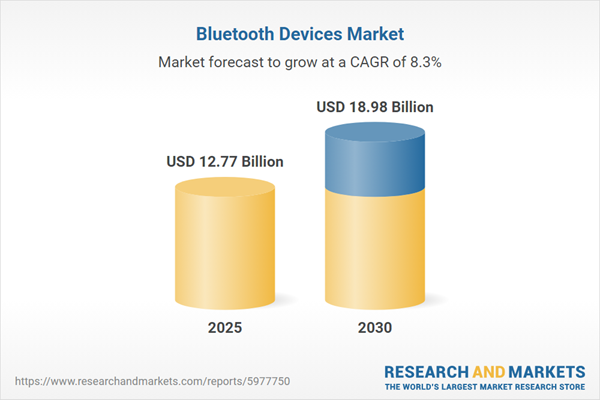Speak directly to the analyst to clarify any post sales queries you may have.
Bluetooth devices are increasingly vital for enterprise connectivity, supporting evolving business demands, seamless workflow integration, and agile digital transformation. As senior decision-makers refine IT strategies, Bluetooth-enabled solutions continue to play a key role in modernizing operations and supporting regulatory compliance across varied markets.
Market Snapshot: Bluetooth Devices Market Growth & Outlook
In 2024, the Bluetooth Devices Market posted significant growth, reaching a value of USD 11.76 billion. Projections estimate expansion to USD 12.77 billion in 2025 and USD 22.61 billion by 2032, reflecting sustained adoption in enterprise environments. Persistent investment in Bluetooth connectivity helps organizations modernize IT infrastructures, drive productivity, and improve collaboration for both remote and on-site teams. Deployment spans manufacturing sites and corporate offices, enabling businesses to align infrastructure strategies with evolving operational requirements and regulatory changes.Scope & Segmentation: Bluetooth Devices Market Analysis
- Product Type: Automotive kits bolster in-vehicle connectivity, supporting efficient fleet management. Computer peripherals—including printers, scanners, keyboards, and mice—enhance workspace productivity. Ear-worn devices such as headsets deliver streamlined communications. Portable and stationary speakers offer robust audio support for team collaboration and presentations. Each category addresses diverse enterprise mobility and workflow needs.
- End User: Core commercial sectors, including healthcare, hospitality, and retail, utilize Bluetooth devices for process automation and workflow integration. Industrial applications in energy, manufacturing, transportation, and utilities drive automation and operational improvements. Growing adoption in home and personal environments points to the expanding reach of Bluetooth-enabled technologies in both professional and domestic settings.
- Distribution Channel: Procurement spans electronics retailers, hypermarkets, specialty stores, corporate procurement, and third-party e-commerce channels. This diversity supports tailored purchasing models suited to enterprise scale, location, and standardization requirements for both established and emerging markets.
- Bluetooth Version: Solutions span legacy to current Bluetooth standards, promoting straightforward integration with multiple hardware generations. This minimizes compatibility risks and eases supplier transitions.
- Power Class: Class 1, Class 2, and Class 3 devices support varying deployment scenarios, from confined workspaces to larger facilities. These classifications help organizations optimize energy consumption and manage coverage depending on operational needs.
- Technology: Bluetooth Classic is selected for stable data transfer and system interoperability, ideal for established business systems. Bluetooth Low Energy enables IoT devices, asset tracking, and wearables, supporting efficiency and device lifespan for enterprise deployments.
- Range: Device options include short-range solutions for personal or desktop use and long-range models for broad commercial environments—accommodating specific workflow or facility challenges and supporting adaptation to operational changes.
- Geographies: The market covers the Americas, Europe, Middle East and Africa, and Asia-Pacific. Each area faces unique compliance needs and deployment challenges, requiring region-specific implementation and regulatory alignment strategies for cross-border operations.
- Key Companies: Leading participants include Apple Inc., Samsung Electronics Co., Ltd., Sony Corporation, Huawei Technologies Co., Ltd., Xiaomi Corporation, Harman International Industries, Inc., Bose Corporation, Guangdong Oppo Mobile Telecommunications Corp., Ltd., GN Audio A/S, and Shenzhen Anker Technology Co., Ltd. Their ongoing innovations shape Bluetooth hardware direction and application scope.
Key Takeaways: Strategic Insights for Senior Decision-Makers
- Integrated Bluetooth solutions create flexible frameworks for collaboration and rapid change management, supporting enterprises navigating digital transformation and workforce mobility.
- Advances in mesh networking bolster asset monitoring and workflow automation, unlocking new opportunities for operational efficiency in both manufacturing and logistics ecosystems.
- Device interoperability is critical for lowering security exposure and simplifying management in environments reliant on a mix of technology vendors and evolving ecosystems.
- Diversified procurement and supplier partnerships ensure business resilience against supply chain variability and regulatory changes, allowing organizations to maintain continuity and adapt to global shifts.
- Regional implementation strategies must address distinct priorities, with the Americas focusing on connected infrastructure development, EMEA emphasizing compliance, and Asia-Pacific leveraging rapid scalability and deployment capabilities for global supply chains.
Tariff Impact: Navigating Evolving Trade Environments
Forthcoming U.S. tariff adjustments in 2025 are prompting manufacturers to broaden production bases and diversify supplier relationships. These efforts support operational stability and strengthen technology deployment strategies, ensuring reliability of Bluetooth infrastructure amid ongoing global trade uncertainties.
Methodology & Data Sources
This report draws on direct interviews with industry stakeholders, expert advisory discussions, patent analysis, and detailed regulatory reviews. Input from trade organizations further supports the thoroughness and validity of the data presented.
Why This Report Matters: Actionable Insights for Leaders
- Enables decision-makers to track Bluetooth Devices Market trends and strengthen strategies for wireless technology adoption and market entry.
- Provides insights on technology flows and regulatory developments, supporting adaptive policy and compliance decisions.
- Supports organizations in refining supply chain strategies and managing technology risk across complex, multi-vendor environments.
Conclusion
Bluetooth devices serve as essential enablers in enterprise infrastructure evolution. Staying informed on technology developments and regulatory changes equips leaders to maintain resilience and business agility in an ever-changing environment.
Additional Product Information:
- Purchase of this report includes 1 year online access with quarterly updates.
- This report can be updated on request. Please contact our Customer Experience team using the Ask a Question widget on our website.
Table of Contents
3. Executive Summary
4. Market Overview
7. Cumulative Impact of Artificial Intelligence 2025
Companies Mentioned
The companies profiled in this Bluetooth Devices market report include:- Apple Inc.
- Samsung Electronics Co., Ltd.
- Huawei Technologies Co., Ltd.
- Xiaomi Corporation
- Harman International Industries, Inc.
- Bose Corporation
- Sony Corporation
- Guangdong Oppo Mobile Telecommunications Corp., Ltd.
- Shenzhen Anker Technology Co., Ltd.
- GN Audio A/S
Table Information
| Report Attribute | Details |
|---|---|
| No. of Pages | 194 |
| Published | November 2025 |
| Forecast Period | 2025 - 2032 |
| Estimated Market Value ( USD | $ 12.77 Billion |
| Forecasted Market Value ( USD | $ 22.61 Billion |
| Compound Annual Growth Rate | 8.5% |
| Regions Covered | Global |
| No. of Companies Mentioned | 11 |









